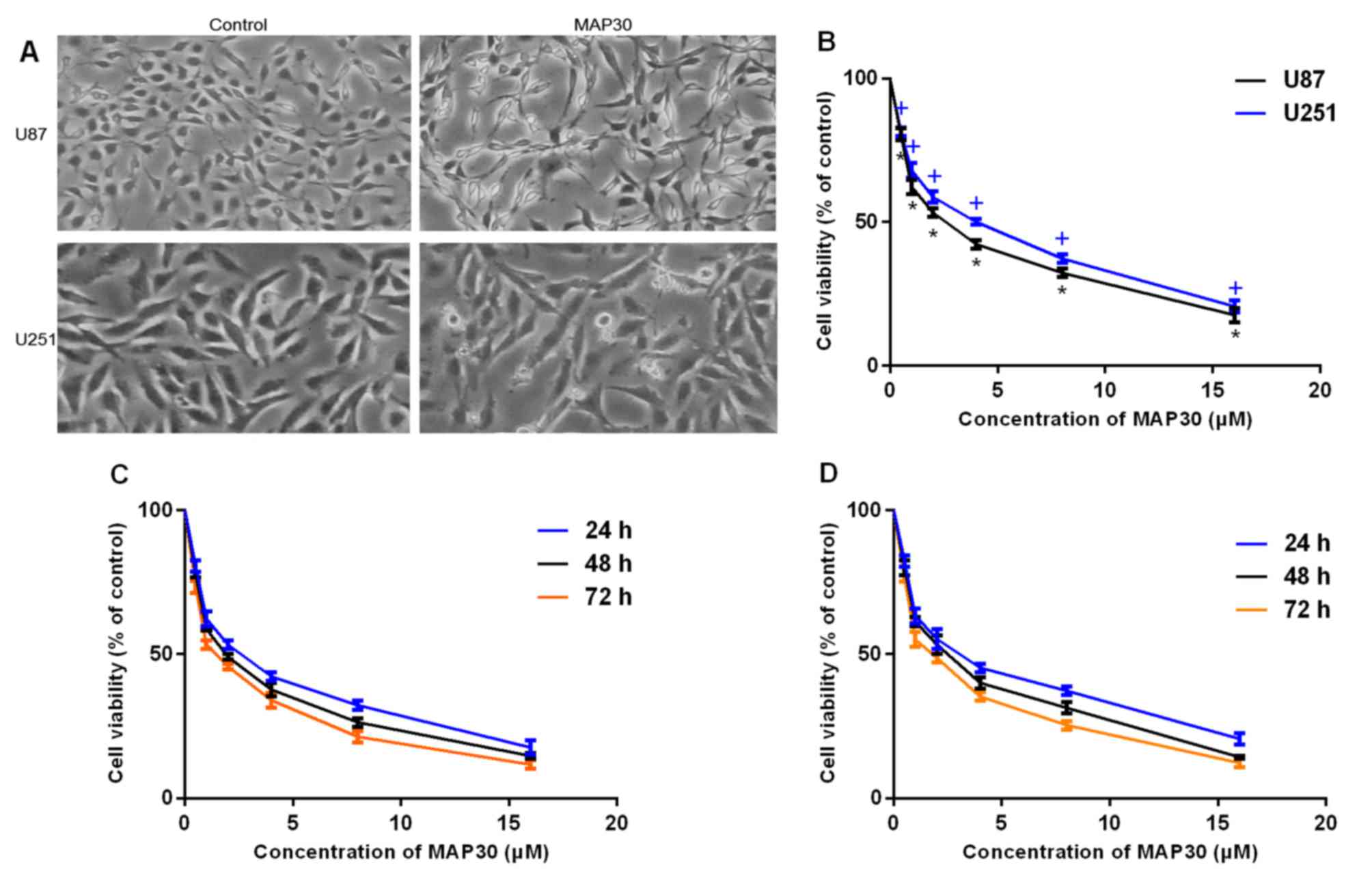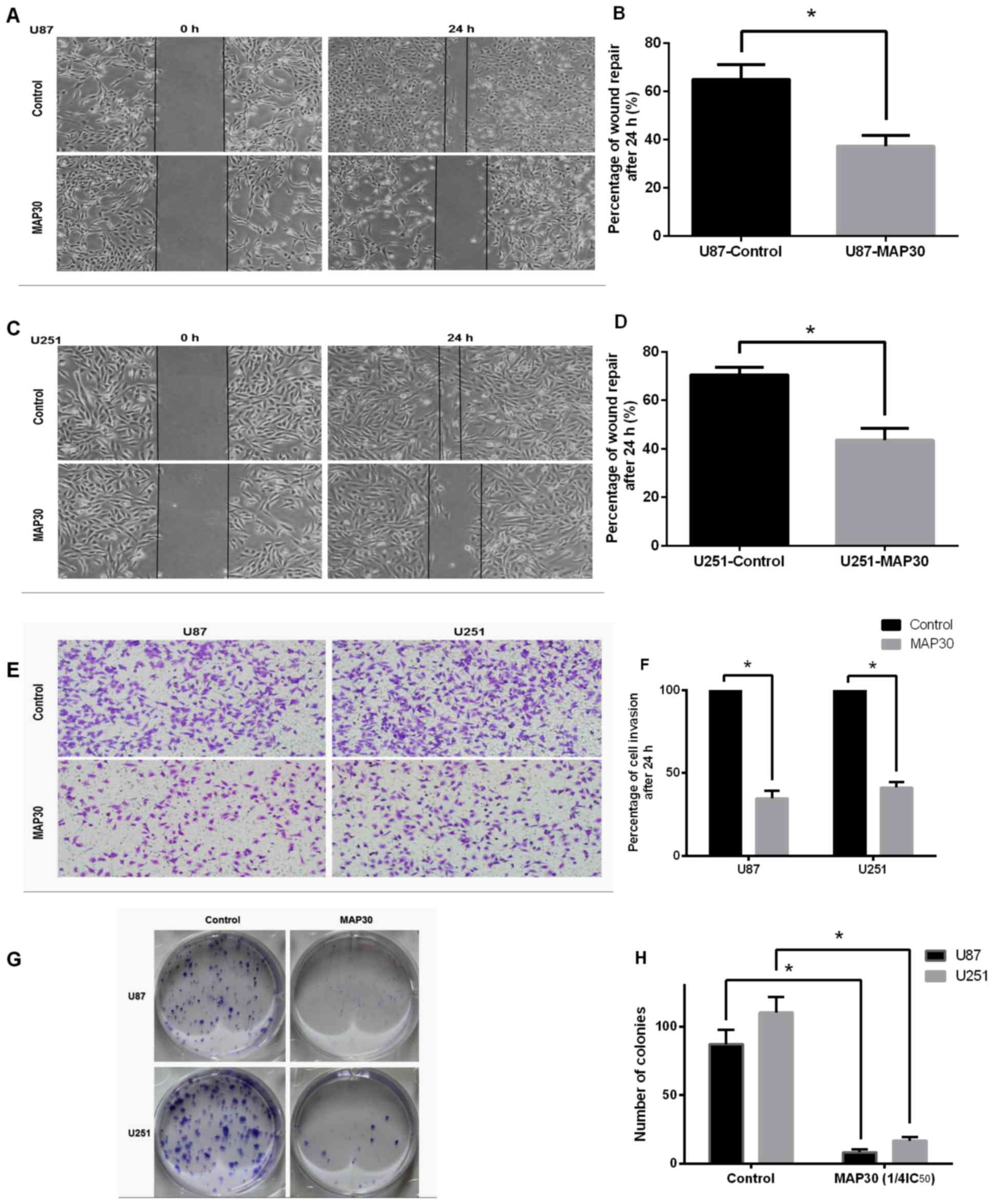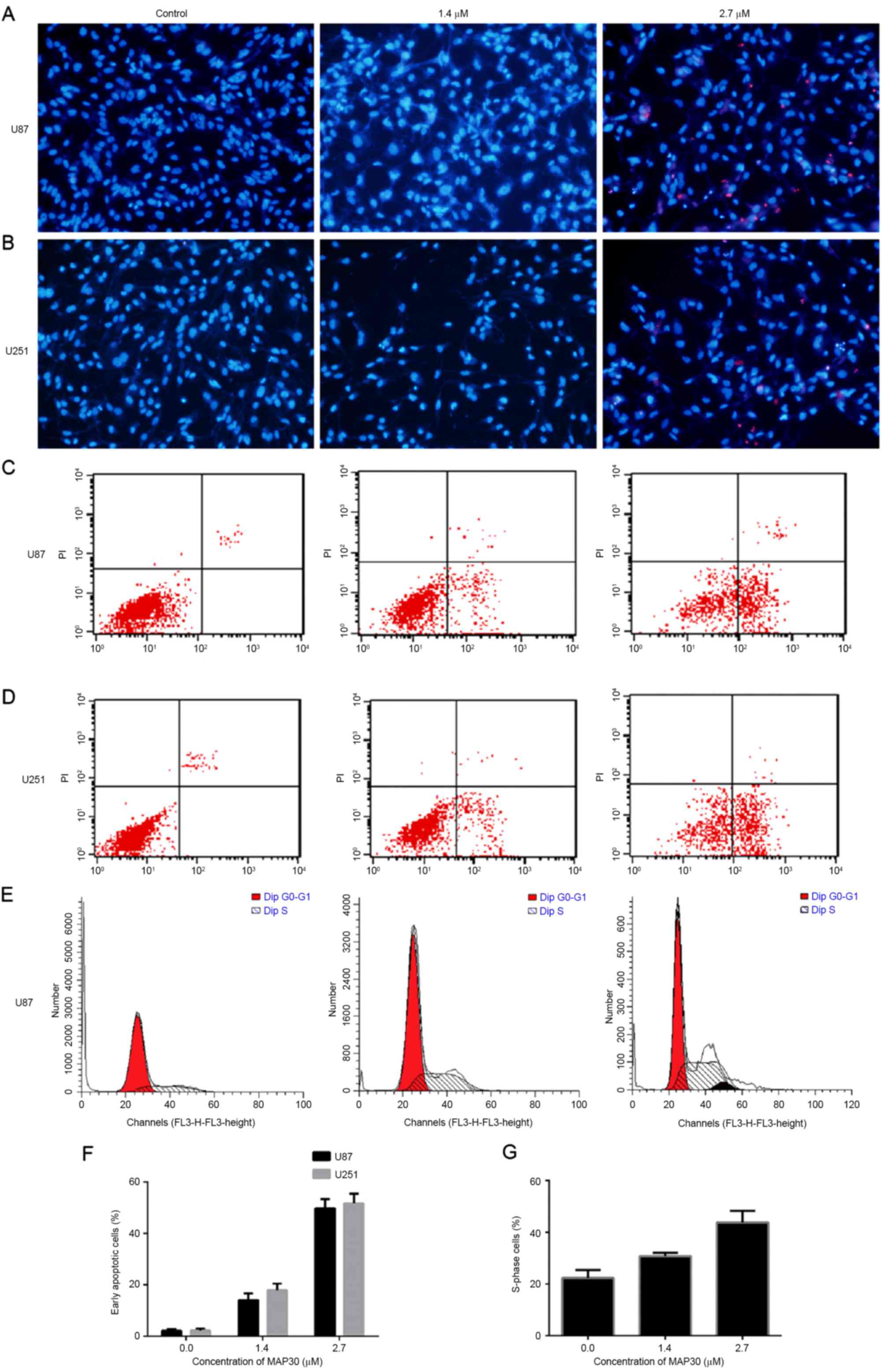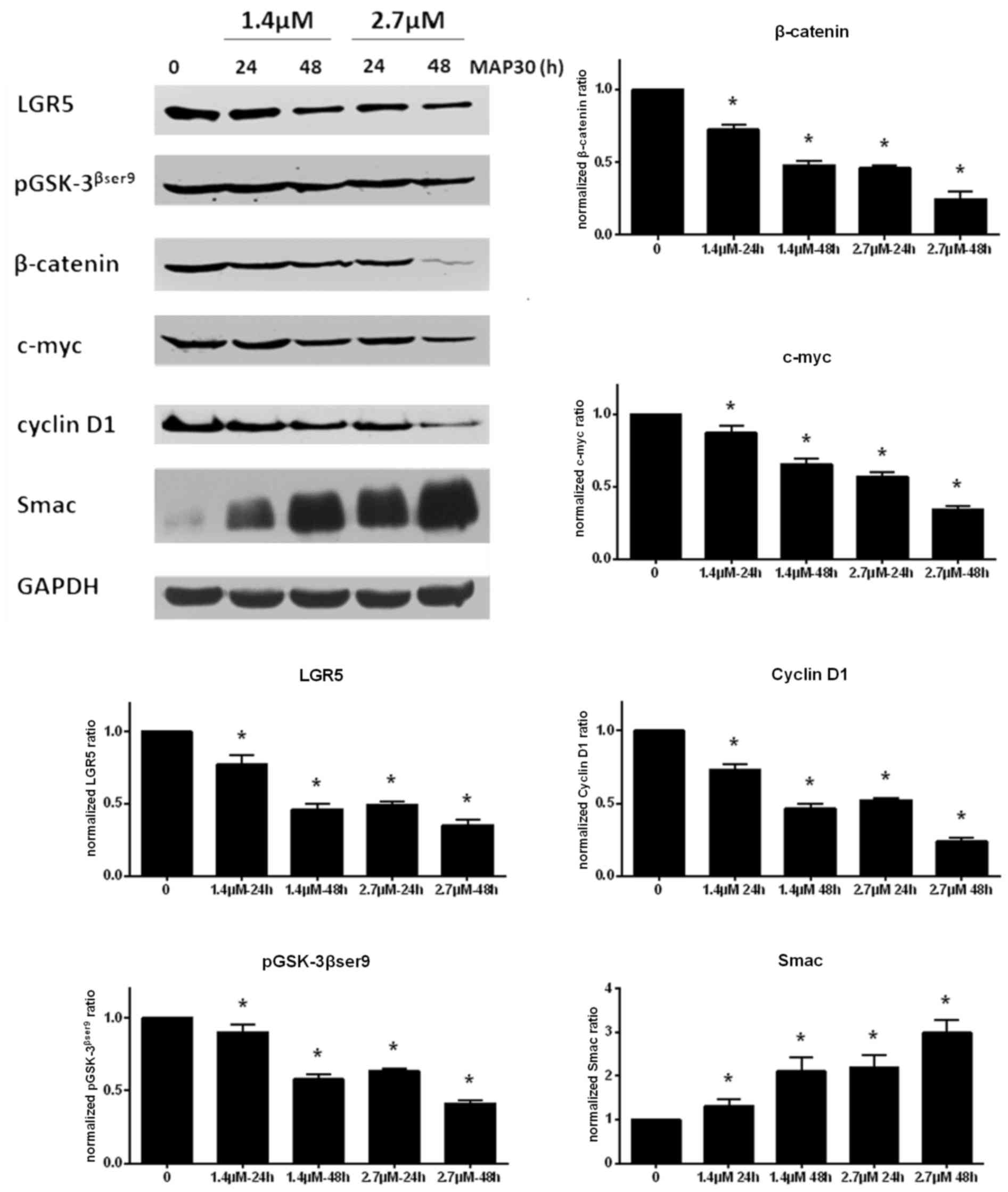|
1
|
Louis DN, Ohgaki H, Wiestler OD, Cavenee
WK, Burger P, Jouvet A, Scheithauer BW and Kleihues P: WHO
classification of tumours of the central nervous system. Acta
Neuropathol. 114:97–109. 2007. View Article : Google Scholar : PubMed/NCBI
|
|
2
|
Tchoghandjian A, Soubéran A, Tabouret E,
Colin C, Denicolaï E, Jiguet-Jiglaire C, El-Battari A, Villard C,
Baeza-Kallee N and Figarella-Branger D: Inhibitor of apoptosis
protein expression in glioblastomas and their in vitro and in vivo
targeting by SMAC mimetic GDC-0152. Cell Death Dis. 7:e23252016.
View Article : Google Scholar : PubMed/NCBI
|
|
3
|
Lee-Huang S and Huang PL, Nara PL, Chen
HC, Kung HF, Huang P, Huang HI and Huang PL: MAP 30: A new
inhibitor of HIV-1 infection and replication. FEBS Lett. 272:12–18.
1990. View Article : Google Scholar : PubMed/NCBI
|
|
4
|
Fang EF, Zhang CZ, Ng TB, Wong JH, Pan WL,
Ye XJ, Chan YS and Fong WP: Momordica Charantia lectin, a type II
ribosome inactivating protein, exhibits antitumor activity toward
human nasopharyngeal carcinoma cells in vitro and in vivo. Cancer
Prev Res (Phila). 5:109–121. 2012. View Article : Google Scholar : PubMed/NCBI
|
|
5
|
Fang EF and Ng TB: Can bitter gourd
(Momordica Charantia) be a novel therapy for human cancers? Cancer
Prev Res. 1–2. 2012.
|
|
6
|
Fang EF and Ng TB: Bitter gourd (Momordica
charantia) is a cornucopia of health: A review of its credited
antidiabetic, anti-HIV and antitumor properties. Curr Mol Med.
11:417–436. 2011. View Article : Google Scholar : PubMed/NCBI
|
|
7
|
Wang X, Sun W, Cao J, Qu H, Bi X and Zhao
Y: Structures of new triterpenoids and cytotoxicity activities of
the isolated major compounds from the fruit of Momordica charantia
L. J Agric Food Chem. 60:3927–3933. 2012. View Article : Google Scholar : PubMed/NCBI
|
|
8
|
Miao J, Jiang Y, Wang D, Zhou J, Fan C,
Jiao F, Liu B, Zhang J, Wang Y and Zhang Q: Trichosanthin
suppresses the proliferation of glioma cells by inhibiting LGR5
expression and the Wnt/β-catenin signaling pathway. Oncol Rep.
34:2845–2852. 2015. View Article : Google Scholar : PubMed/NCBI
|
|
9
|
Grover JK and Yadav SP: Pharmacological
actions and potential uses of Momordica charantia: A review. J
Ethnopharmacol. 93:123–132. 2004. View Article : Google Scholar : PubMed/NCBI
|
|
10
|
Dandawate PR, Subramaniam D, Padhye SB and
Anant S: Bitter melon: A panacea for inflammation and cancer. Chin
J Nat Med. 14:81–100. 2016.PubMed/NCBI
|
|
11
|
Raina K, Kumar D and Agarwal R: Promise of
bitter melon (Momordica charantia) bioactives in cancer prevention
and therapy. Semin Cancer Biol 40–41. 1–129. 2016.
|
|
12
|
Lv Q, Yang XZ, Fu LY, Lu YT, Lu YH, Zhao J
and Wang FJ: Recombinant expression and purification of a
MAP30-cell penetrating peptide fusion protein with higher
anti-tumor bioactivity. Protein Expr Purif. 111:9–17. 2015.
View Article : Google Scholar : PubMed/NCBI
|
|
13
|
Fan X, He L and Meng Y, Li G, Li L and
Meng Y: A-MMC and MAP30, two ribosome-inactivating proteins
extracted from Momordica charantia, induce cell cycle arrest and
apoptosis in A549 human lung carcinoma cells. Mol Med Rep.
11:3553–3558. 2015. View Article : Google Scholar : PubMed/NCBI
|
|
14
|
Fang EF, Zhang CZ, Wong JH, Shen JY, Li CH
and Ng TB: The MAP30 protein from bitter gourd (Momordica
charantia) seeds promotes apoptosis in liver cancer cells in vitro
and in vivo. Cancer Lett. 324:66–74. 2012. View Article : Google Scholar : PubMed/NCBI
|
|
15
|
Fan JM, Luo J, Xu J, Zhu S, Zhang Q, Gao
DF, Xu YB and Zhang GP: Effects of recombinant MAP30 on cell
proliferation and apoptosis of human colorectal carcinoma LoVo
cells. Mol Biotechnol. 39:79–86. 2008. View Article : Google Scholar : PubMed/NCBI
|
|
16
|
Fang EF, Ng TB, Shaw PC and Wong RN:
Recent progress in medicinal investigations on trichosanthin and
other ribosome inactivating proteins from the plant genus
Trichosanthes. Curr Med Chem. 18:4410–4417. 2011. View Article : Google Scholar : PubMed/NCBI
|
|
17
|
Wang YX, Neamati N, Jacob J, Palmer I,
Stahl SJ, Kaufman JD, Huang PL, Huang PL, Winslow HE, Pommier Y, et
al: Solution structure of anti-HIV-1 and anti-tumor protein MAP30:
Structural insights into its multiple functions. Cell. 99:433–442.
1999. View Article : Google Scholar : PubMed/NCBI
|
|
18
|
Meng Y, Lin S, Liu S, Fan X, Li G and Meng
Y: A novel method for simultaneous production of two
ribosome-inactivating proteins, α-MMC and MAP30, from Momordica
charantia L. PLoS One. 9:e1019982014. View Article : Google Scholar : PubMed/NCBI
|
|
19
|
Chinot OL, Wick W, Mason W, Henriksson R,
Saran F, Nishikawa R, Carpentier AF, Hoang-Xuan K, Kavan P, Cernea
D, et al: Bevacizumab plus radiotherapy-temozolomide for newly
diagnosed glioblastoma. N Engl J Med. 370:709–722. 2014. View Article : Google Scholar : PubMed/NCBI
|
|
20
|
Wick W, Chinot OL, Bendszus M, Mason W,
Henriksson R, Saran F, Nishikawa R, Revil C, Kerloeguen Y and
Cloughesy T: Evaluation of pseudoprogression rates and tumor
progression patterns in a phase III trial of bevacizumab plus
radiotherapy/temozolomide for newly diagnosed glioblastoma. Neuro
Oncol. 18:1434–1441. 2016. View Article : Google Scholar : PubMed/NCBI
|
|
21
|
Hlin H, Zhi-Guo Z, Cong-Hui H, Yan Z, Qing
L, Bo J, Hou-Guang H, Jun-Jie Z and Pei-Ying Z: Expression of
Momordica charantia MAP30 and its anti-tumor effect on bladder
cancer cells. Minerva Urol Nefrol. 68:275–281. 2014.PubMed/NCBI
|
|
22
|
Meng Y, Liu S, Li J, Meng Y and Zhao X:
Preparation of an antitumor and antivirus agent: chemical
modification of α-MMC and MAP30 from Momordica Charantia L. with
covalent conjugation of polyethyelene glycol. Int J Nanomedicine.
7:3133–3142. 2012.PubMed/NCBI
|
|
23
|
Allen M, Bjerke M, Edlund H, Nelander S
and Westermark B: Origin of the U87MG glioma cell line: Good news
and bad news. Sci Transl Med. 8:354re32016. View Article : Google Scholar : PubMed/NCBI
|
|
24
|
Bedini A, Baiula M, Vincelli G, Formaggio
F, Lombardi S, Caprini M and Spampinato S: Nociceptin/orphanin FQ
antagonizes lipopolysaccharide-stimulated proliferation, migration
and inflammatory signaling in human glioblastoma U87 cells. Biochem
Pharmacol. 140:89–104. 2017. View Article : Google Scholar : PubMed/NCBI
|
|
25
|
Heckler M, Osterberg N, Guenzle J,
Thiede-Stan NK, Reichardt W, Weidensteiner C, Saavedra JE and
Weyerbrock A: The nitric oxide donor JS-K sensitizes U87 glioma
cells to repetitive irradiation. Tumour Biol.
39:10104283177039222017. View Article : Google Scholar : PubMed/NCBI
|
|
26
|
Alphandéry E, Idbaih A, Adam C, Delattre
JY, Schmitt C, Guyot F and Chebbi I: Development of non-pyrogenic
magnetosome minerals coated with poly-l-lysine leading to full
disappearance of intracranial U87-Luc glioblastoma in 100% of
treated mice using magnetic hyperthermia. Biomaterials.
141:210–222. 2017. View Article : Google Scholar : PubMed/NCBI
|
|
27
|
Alphandéry E, Idbaih A, Adam C, Delattre
JY, Schmitt C, Guyot F and Chebbi I: Chains of magnetosomes with
controlled endotoxin release and partial tumor occupation induce
full destruction of intracranial U87-Luc glioma in mice under the
application of an alternating magnetic field. J Control Release.
262:259–272. 2017. View Article : Google Scholar : PubMed/NCBI
|
|
28
|
Ru P, Steele R, Nerurkar PV, Phillips N
and Ray RB: Bitter melon extract impairs prostate cancer cell-cycle
progression and delays prostatic intraepithelial neoplasia in TRAMP
model. Cancer Prev Res (Phila). 4:2122–2130. 2011. View Article : Google Scholar : PubMed/NCBI
|
|
29
|
Brennan VC, Wang CM and Yang WH: Bitter
melon (Momordica charantia) extract suppresses adrenocortical
cancer cell proliferation through modulation of the apoptotic
pathway, steroidogenesis and insulin-like growth factor type 1
receptor/RAC-alpha serine/threonine-protein kinase signaling. J Med
Food. 15:325–334. 2012. View Article : Google Scholar : PubMed/NCBI
|
|
30
|
Ray RB, Raychoudhuri A, Steele R and
Nerurkar P: Bitter melon (Momordica charantia) extract inhibits
breast cancer cell proliferation by modulating cell cycle
regulatory genes and promotes apoptosis. Cancer Res. 70:1925–1931.
2010. View Article : Google Scholar : PubMed/NCBI
|
|
31
|
Rot S, Taubert H, Bache M, Greither T,
Würl P, Eckert AW, Schubert J, Vordermark D and Kappler M: A novel
splice variant of the stem cell marker LGR5/GPR49 is correlated
with the risk of tumor-related death in soft-tissue sarcoma
patients. BMC Cancer. 11:4292011. View Article : Google Scholar : PubMed/NCBI
|
|
32
|
Yi GZ, Liu YW, Xiang W, Wang H, Chen ZY,
Xie SD and Qi ST: Akt and β-catenin contribute to TMZ resistance
and EMT of MGMT negative malignant glioma cell line. J Neurol Sci.
367:101–106. 2016. View Article : Google Scholar : PubMed/NCBI
|
|
33
|
Morris SL and Huang S: Crosstalk of the
Wnt/β-catenin pathway with other pathways in cancer cells. Genes
Dis. 3:41–47. 2016. View Article : Google Scholar : PubMed/NCBI
|
|
34
|
Barker N and Clevers H: Leucine-rich
repeat-containing G-protein-coupled receptors as markers of adult
stem cells. Gastroenterology. 138:1681–1696. 2010. View Article : Google Scholar : PubMed/NCBI
|
|
35
|
Barker N, van Es JH, Kuipers J, Kujala P,
van den Born M, Cozijnsen M, Haegebarth A, Korving J, Begthel H,
Peters PJ and Clevers H: Identification of stem cells in small
intestine and colon by marker gene Lgr5. Nature. 449:1003–1007.
2007. View Article : Google Scholar : PubMed/NCBI
|
|
36
|
Hsu SY, Kudo M, Chen T, Nakabayashi K,
Bhalla A, van der Spek PJ, van Duin M and Hsueh AJ: The three
subfamilies of leucine-rich repeat-containing G protein-coupled
receptors (LGR): Identification of LGR6 and LGR7 and the signaling
mechanism for LGR7. Mol Endocrinol. 14:1257–1271. 2000. View Article : Google Scholar : PubMed/NCBI
|
|
37
|
Wang D, Zhou J, Fan C, Jiao F, Liu B, Sun
P, Miao J and Zhang Q: Knockdown of LGR5 suppresses the
proliferation of glioma cells in vitro and in vivo. Oncol Rep.
31:41–49. 2014. View Article : Google Scholar : PubMed/NCBI
|
|
38
|
Hsu HC, Liu YS, Tseng KC, Tan BC, Chen SJ
and Chen HC: LGR5 regulates survival through mitochondria-mediated
apoptosis and by targeting the Wnt/β-catenin signaling pathway in
colorectal cancer cells. Cell Signal. 26:2333–2342. 2014.
View Article : Google Scholar : PubMed/NCBI
|
|
39
|
Fulda S: Promises and challenges of smac
mimetics as cancer therapeutics. Clin Cancer Res. 21:5030–5036.
2015. View Article : Google Scholar : PubMed/NCBI
|
|
40
|
Marschall V and Fulda S: Smac
mimetic-induced upregulation of interferon-β sensitizes
glioblastoma to temozolomide-induced cell death. Cell Death Dis.
6:e18882015. View Article : Google Scholar : PubMed/NCBI
|
|
41
|
Mizukawa K, Kawamura A, Sasayama T, Tanaka
K, Kamei M, Sasaki M and Kohmura E: Synthetic Smac peptide enhances
the effect of etoposide-induced apoptosis in human glioblastoma
cell lines. J Neurooncol. 77:247–255. 2006. View Article : Google Scholar : PubMed/NCBI
|
|
42
|
Amendola D, De Salvo M, Marchese R, Verga
Falzacappa C, Stigliano A, Carico E, Brunetti E, Moscarini M and
Bucci B: Myc down-regulation affects cyclin D1/cdk4 activity and
induces apoptosis via Smac/Diablo pathway in an astrocytoma cell
line. Cell Prolif. 42:94–109. 2009. View Article : Google Scholar : PubMed/NCBI
|
|
43
|
Scheidereit C: IkappaB kinase complexes:
Gateways to NF-kappaB activation and transcription. Oncogene.
25:6685–6705. 2006. View Article : Google Scholar : PubMed/NCBI
|
|
44
|
Sun Y, Sun F, Li J, Wu M, Fan X and Meng Y
and Meng Y: Mono-PEGylation of Alpha-MMC and MAP30 from Momordica
charantia L: Production, identification and anti-tumor activity.
Molecules. 21:E14572016. View Article : Google Scholar : PubMed/NCBI
|
|
45
|
Huang PL, Sun Y, Chen HC, Kung HF and
Lee-Huang S: Proteolytic fragments of anti-HIV and anti-tumor
proteins MAP30 and GAP31 are biologically active. Biochem Biophys
Res Commun. 262:615–623. 1999. View Article : Google Scholar : PubMed/NCBI
|
|
46
|
Schreiber CA, Wan L, Sun Y, Lu L, Krey LC
and Lee-Huang S: The antiviral agents, MAP30 and GAP31, are not
toxic to human spermatozoa and may be useful in preventing the
sexual transmission of human immunodeficiency virus type 1. Fertil
Steril. 72:686–690. 1999. View Article : Google Scholar : PubMed/NCBI
|
|
47
|
Putnam CD and Tainer JA: The food of sweet
and bitter fancy. Nat Struct Biol. 7:17–18. 2000. View Article : Google Scholar : PubMed/NCBI
|













